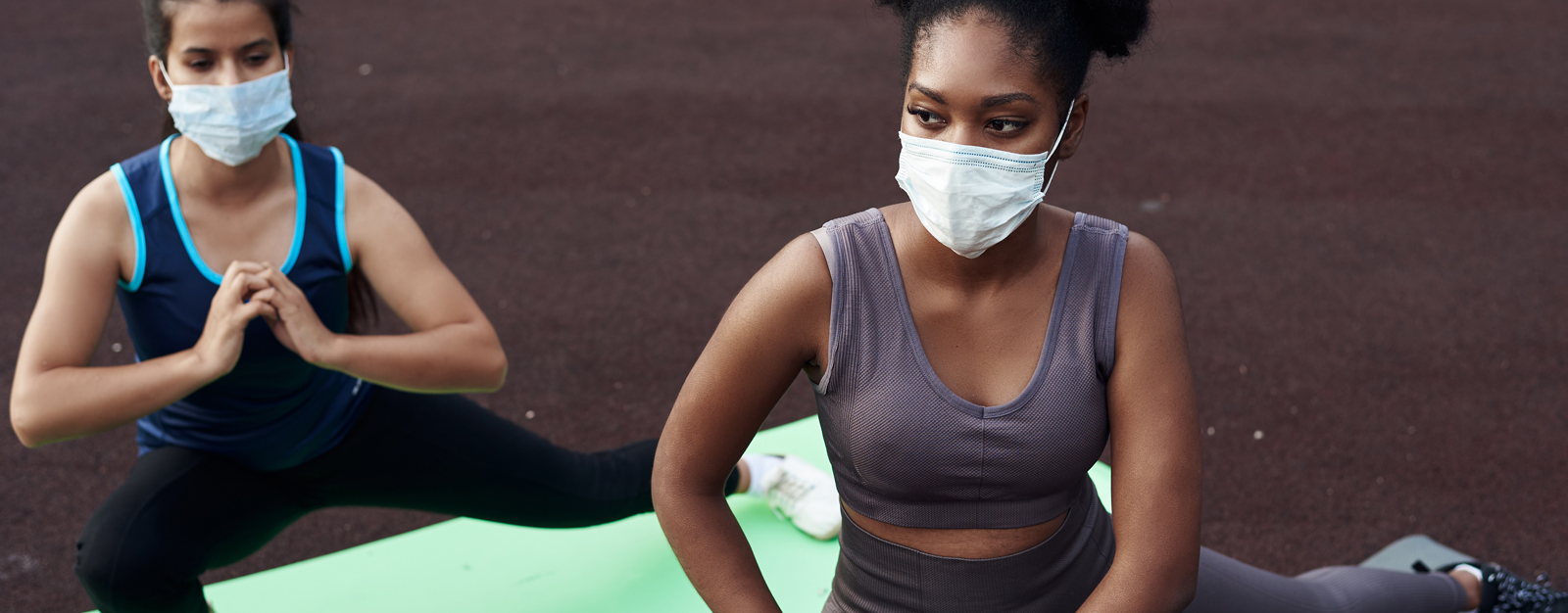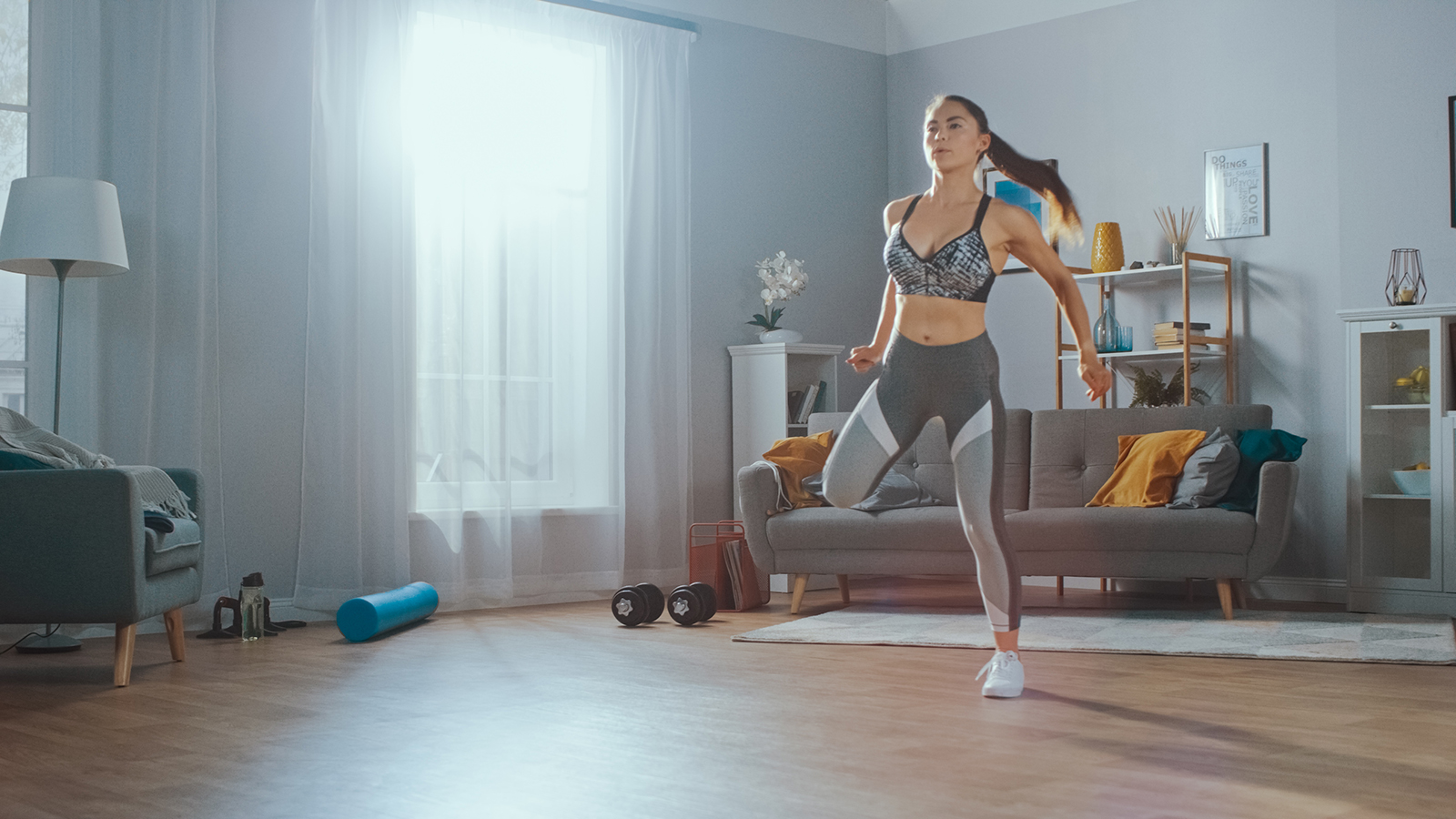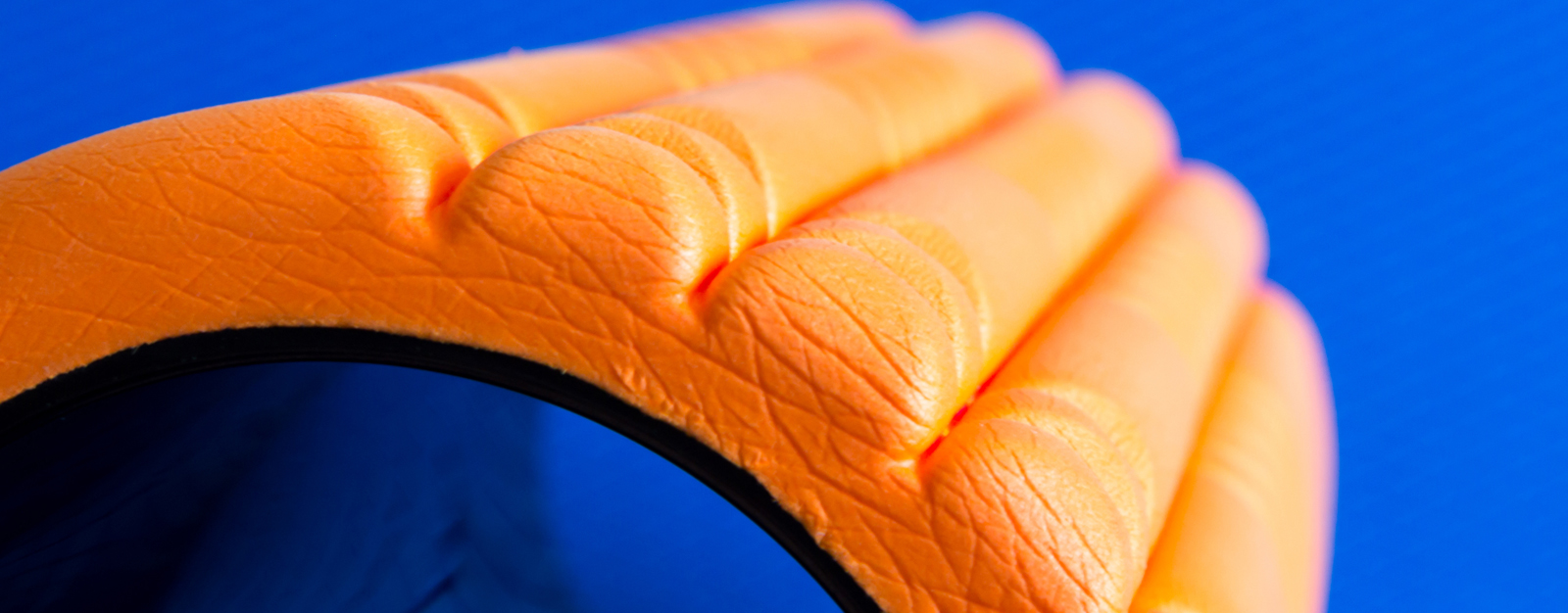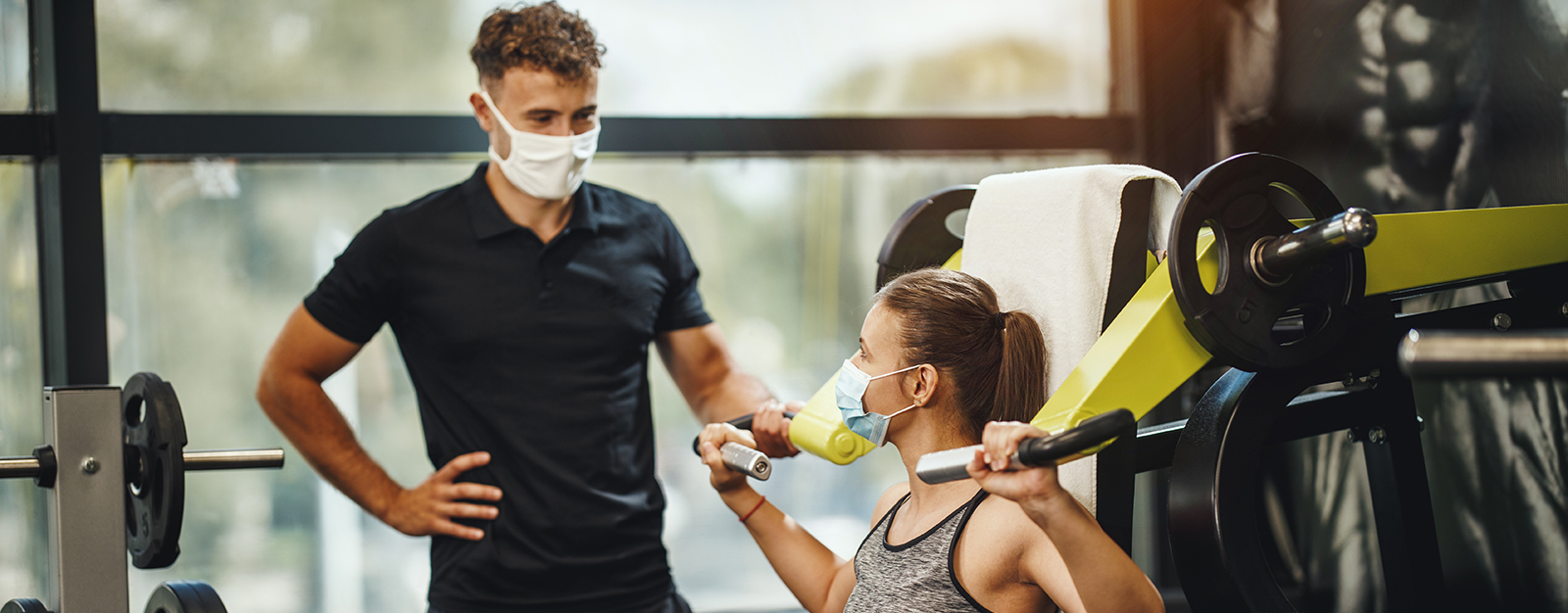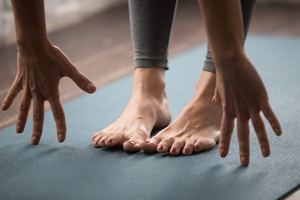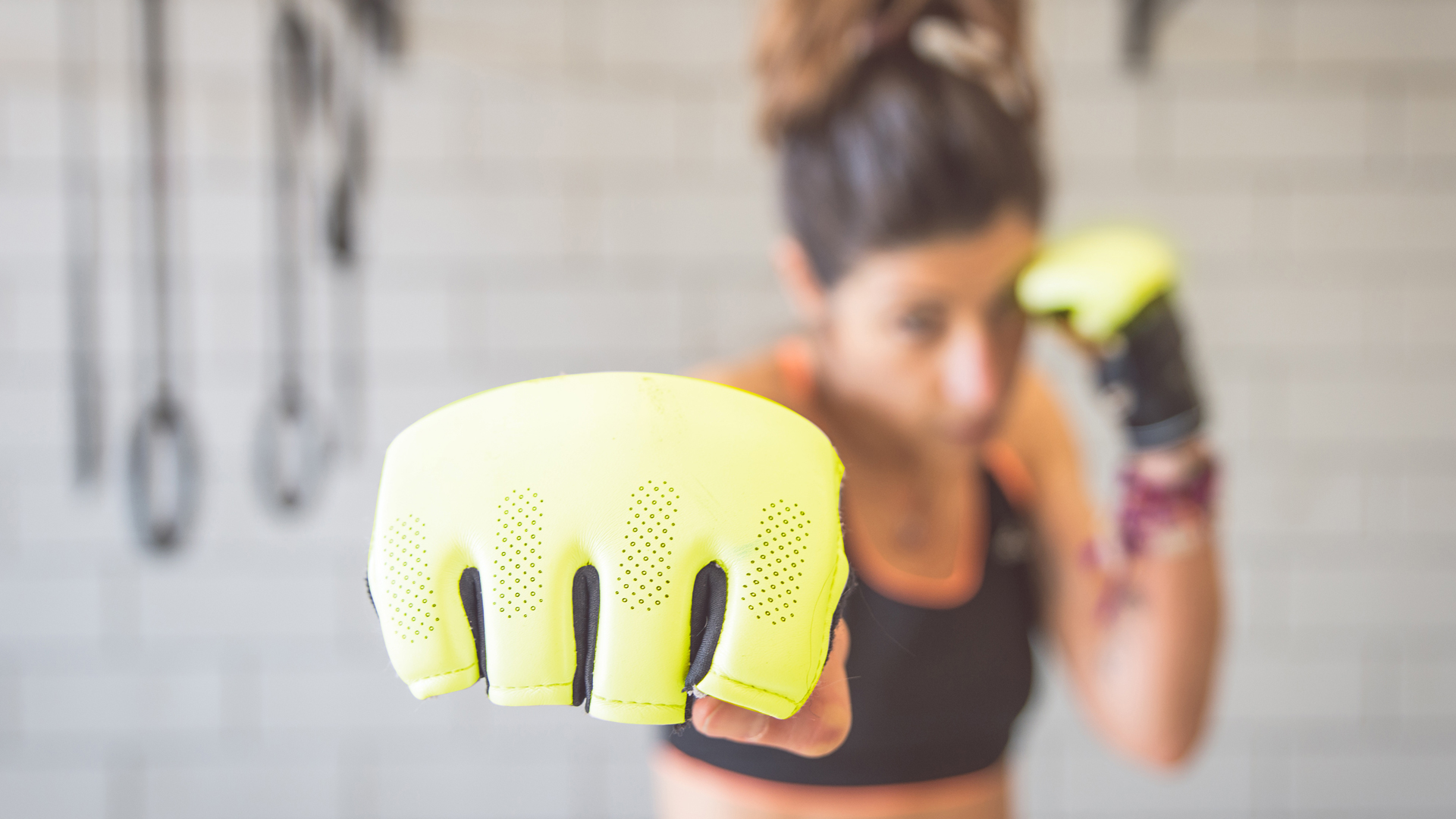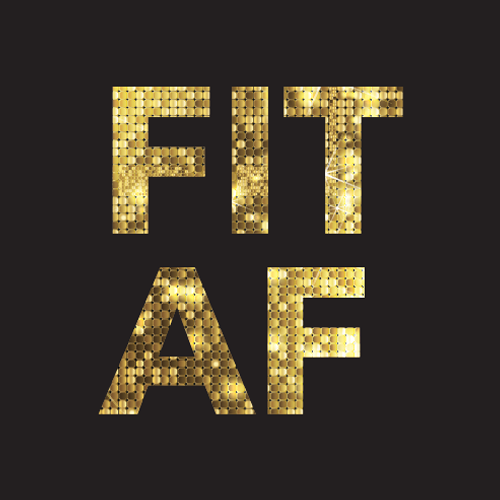The Holidays feel weird this year, there’s no denying it. But what’s weird can also be wonderful, with a little resiliency and ingenuity.
Continue readingThe Anti-depressant Effects of Fitness
Fitness can do more than just build your confidence or help you drop and gain pounds. Turns out, it’s just the superhero we need.
Continue readingFitness Fights Disease
Fitness can do more than just build your confidence or help you drop and gain pounds. Turns out, it’s just the superhero we need.
Continue readingMobility is Not a Punchline
Mobility workouts are not a cheat day, they’re a necessary part of improving your performance. Find out more.
Continue readingWearing a Mask While Working Out
The type of mask you choose can make or break your workout. Find out how to pick the right one for you!
Continue readingCoping with Anxiety and COVID-19

Coping with Anxiety during COVID-19 Isolation
By nature, humans are social creatures. As the species has evolved, being in groups has proven beneficial not only for behavioral development and education, but also for survival. Studies have shown that social interaction influences us in a neurobiological sense, releasing or enhancing certain hormones and physiological responses. With the recent “shelter-in-place” mandates in New York State and elsewhere, this newfound isolation and suspension of common routines has thrown the population into new and uncharted waters, the impact of which we are only just now beginning to realize.
“Humans thrive on routine,” explains Sociology and Psychology teacher Rose Gorman, a VENT Fitness member who teaches at Troy High School. Her efforts in the recent shelter-at-home environment have been primarily focused on keeping her students engaged in the new online teaching environment, while simultaneously turning their attention to both the societal and historical impacts of the COVID-19 outbreak. “This dramatic break in routine can not only cause anxiety for people who are already prone to it, but can also manifest in people who don’t typically deal with it.”
While most scientists can agree that social interaction is crucial to the human existence, there is little known about the neural (read: functions of the brain) factors that are behind that need. And while the advent of video chat has been helpful in connecting humans in times of distance, the simple facial recognition doesn’t provide the same depth of connection (see also: how much your kids text). The early results are in — human interaction in person produces hormonal responses in us, and this new isolation has put a new twist on things, generally labeled as “anxiety.”
Symptoms of anxiety are wide-ranging, Gorman explains, and the evidence isn’t always clear. “Sleeplessness, irritability, the inability to focus, these are all common but sneaky examples of anxiety,” she explains. And while the Capital District and beyond are a week or more into sheltering in place, the disruption in routine is likely to affect the entire household. “Even your pets may act a little differently,” Gorman says. But there are ways to cope that are simple, and easy to adapt into your new stay-home-schedule.
First, Gorman suggests a 20 minute break. “Yoga, a walk, a focused relaxation exercise, you can pick anything so long as you leave your technology behind. The idea is to give yourself a real break.” She suggests paying special attention to the sights and sounds around you, rather than the technology of our devices. Your brain needs this time to recalibrate.
Meditation, either via an app, website, or self-guided, can prove invaluable. The effects of meditation are well-known, and even if you’re new at it, there are still benefits, such as improved concentration, attention span, and overall well-being. And evidence suggests meditation can actually change the structure of the brain. A study out of Harvard University found that after just eight weeks of targeted meditation, subjects saw increased cortical thickness in the hippocampus, the area of the brain that governs learning and memory, while also decreasing the brain cell volume in the amygdala, the center for fear, anxiety and stress responses (think Anger from “Inside Out.”) Try an app like Calm or Headspace if you need some additional guidance.
Another way Gorman suggests to overcome your concerns is doing things for others — think of it as volunteerism, but close to home. Got a partner who hates doing the dishes? Got a mountain of laundry to do? Working together while doing something helpful can derail some of your stress. Plus, organizing and cleaning can have mental health benefits as well, by allowing some control over your otherwise topsy-turvy environment.
“Try a gratefulness exercise,” Gorman says. “Take one or more of the suggested prompts and reflect on the answers. Better yet, try writing your answers down.” Writing — or journaling, its free-form cousin — as it turns out, is a great coping tool. Committing words to writing, and the actual process of putting them down on paper, forces the brain to organize the information differently than it would when speaking or typing. Evidence also suggests the physical process of writing actually sends electrical currents through portions of the brain that regulate emotions, pathways that aren’t used when typing. Think of the handwriting process as a built in opportunity to reflect on anything that you can think of, whether it be positive or negative. This will pave the way to re-organize your thinking, your priorities, and your focus.
And the idea that your brain retains handwritten information more than other styles of documentation is not just the preference of your old English professor. A study from Princeton and UCLA demonstrates that note taking, with an old-fashioned pen and paper, allowed students to retain more factual detail and conceptual comprehension. And, given the historically significant phenomenon that COVID-19 presents, there is plenty to document.
Stuck for something to write? Gorman has a handy list of prompts. “Document what the government has announced, and record your reaction to it. Does it makes sense to you? Does it impact you or someone you know? How did you and your family respond?” Then, she suggests investigating your surroundings — what portions of your neighborhood are open? What kind of people are out? Do you see things that give you hope?
“Right now it’s ok to explore your feelings of concern, or fear, because humans are developed to have these responses,” Gorman says. “If you can identify them, you can also overcome them. And by re-routing your thoughts into more positive, optimistic avenues, you can help strengthen your sense of well-being.”
Rose Gorman has taught in the Troy City School District for the past seven years at both Troy High School and Troy Middle School. Currently, she teaches Psychology and Sociology courses through the University at Albany through the University in the High School program at Troy High. She is also the Work-Based Learning Coordinator and one of the College and Career Liaisons, where she partners with community members and businesses to place students in internships.
The Science of Self-Care
Self-care. It’s a term we’ve heard more and more these days, and it may conjure ideas of bubble baths, manicures, alone time in the man cave or in front of Netflix with wine. But more than just a new age buzzword, self-care has become increasingly important as the nation — and the international community — struggle in new and uncertain times. And science says it’s more than self-indulgence or a marketing pitch, it’s survival.
Self-care is generally defined as the effort needed to eat and hydrate properly, reduce stress, and build resilience for the challenges of today’s modern life. And it’s no surprise with the prevalence of technology, the need to work, and oftentimes the effort required to manage a home, finances, and child-rearing, self-care may not be at the top of your list. Typically, the time to invest into one’s own mental health takes a backseat to nearly all other obligations, but science has found out putting yourself last may be a major contributing factor to not only your sense of stress, but also your unshakable sense of burnout.
“What concerns me is that all too often, I see strong, successful professionals succumb to illness and get really, really sick and only then do they manage to get the much needed break to catch their breath or slow down and change direction,” said New York-based clinician Maria Baratta, Ph.D., L.C.S.W. “I think there’s a better way, and incorporating self care every day helps to serve as an armor to protect the energy that we need in order to survive and thrive.”
In fact, self-care can act as “emotional first aid” during particularly stressful times, explains Alice Boyes, Ph.D., author of The Anxiety Toolkit. When faced with a particularly high level stressor — the loss of a job, a breakup, or like now, a health crisis — self-care can help shuffle your focus away from the negativity. By putting well-being first, Boyes says, it can help replenish energy levels, help balance out your patience and improve your efficiency, thus increasing your ability to face your stressors head on. And don’t just think it requires a bath or alone time — it can be anything you do to step out of your current stresses, and can be enhanced by setting boundaries to avoid new ones. (Struggle with saying no? Click here to learn how to say no without the guilt).
Those moments of decompression should also take place more often than just after work, Baratta suggests. Be mindful of the cues that indicate you might be in need of a break. Have you noticed you’re unable to focus? Have you found yourself clumsier than usual? It might be time to step away. Turning down the distractions, taking a brief walk, and hydrating for even just a few minutes will help your brain pause. And don’t presume that because you are home, your stress level is lower. The temptation to throw in a load of laundry in the midst of your work-from-home schedule can be tempting, but this can also lead to an even blurrier line between work and life. Try and keep to your typical work schedule, with the aforementioned “pauses.” Then, schedule yourself daily “me time” to recharge. (If it involves wine or binge-watching your favorite show, so be it. These are the moments you can indulge.)
And now more than ever, exercise can be helpful in both building immunity and reducing stress. Given your current task load, it may seem more daunting than ever to find the time or enthusiasm to workout. But workouts are more available than ever before: whether you prefer in-person or live-streaming, there are more options than ever to fit a few minutes of fitness into your everyday. And with plenty of options to modify the challenges, plus scaleable workouts to fit into your schedule, exercise can be the perfect complement to your other self-care plans.
Need some inspiration? You can access hundreds of workout models in the VENT Fitness app. Or, you can view our most up-to-date schedule and try out any of our MOVE, RIDE, AQUA, or STUDIO group workouts.
Regardless of how you choose to mandate your self-care, the key is to treat it as a non-negotiable. As people globally are adapting to our new circumstances, it’s more crucial than ever to be mindful of your own level of health and well-being. Now is the time to set aside a few minutes each day, throughout the day, for ensuring you are your strongest, both physically and mentally.
Need more inspiration? Be sure to follow VENT on Instagram.
See you in the clubs!
Don’t Let the Gym “Scare the FIT” out of you!
Because its not as scary as it looks… I promise.
The Story:
Just a few months back, the mere thought of going to the gym “scared the FIT” out of me. Up until now, I didn’t attend the gym on a regular basis, so I often didn’t know which weights to choose, how long I should workout for, or even how to operate the machines. My lack of knowledge caused my entire body to be overwhelmed with fear and anxiety each time I stepped into the gym. I thought to myself “Would people laugh at me?” “Would they judge me during my workout?” “Will I be one of those people who go viral for being secretly recorded while doing an exercise COMPLETELY wrong?”
So…One day, I decided to put my big-girl pants on, and began meeting with a VENT personal trainer once a week. Within the first month of meeting with her, all my questions, worries, fears, anxieties, and concerns about the gym DISAPPEARED!
Myth #1 | “Everyone’s looking at me.” Believe it or not, this is a universal concern. Whether you’re a decorated athlete, or a fitness beginner, everyone has a point (or points) in the gym when they think “oh boy, all eyes are on me!” Truth is, most people aren’t looking at you. During my workout I tend to be so focused on what I’m doing that I gaze off into space, so much so that I sometimes find one thing to stare at to keep me focused and engaged. Especially when its busy at the gym, sometimes that “space” happens to be near someone else. Next time you see someone looking in your direction, don’t get nervous– in fact, give them a little head nod! Chances are they’re just as worried about you looking at them, as you are about them looking at you. Giving a simple smile and/or head nod will be just enough acknowledgement to help break the ice and halt any existing anxiety.
Myth #2 | “I have to know what I’m doing to have a personal trainer.” Our personal trainers are here to help you reinVENT yourself. Surprisingly, they actually care! If you’re new to VENT, or new to working out in general, meeting with a personal trainer is the perfect way to get you started! Meeting with my trainer helped me learn hundreds of exercises to do during my workouts. She even helped me learn how to operate the most intimidating machines! Now I walk on to the workout floor more confident than ever! While I invested in my physical health, and am obviously motivated by sculpting my physique, I learned that what I’ve also invested in is a life long commitment to reinVENTion, one that I don’t think I would have discovered if it weren’t for my personal trainer. I speak from experience when I say you most definitely do not need to be a “gym expert” to meet with a personal trainer.
Contributors:
Victoria Smith, Marketing Support Intern
Jermaine Wright, Marketing and Promotions Manager
///////////////////////////////////////////////////////////
5 Tips to Help you Eat Healthy this Holiday Season
Where there’s a will, there’s a way!
Apple cider donuts, pumpkin pie and homemade whipped cream…sticking to your diet can be quite a challenge once the holidays roll back around. Check out 5 tips from Julia Christopher, a VENT Niskayuna personal trainer and VENT Studio instructor, that can help you stay on track this holiday season.
“So it’s that time of year again when holiday parties are in season, portions sizes become bigger, football is every Sunday, and the urge to indulge is ever present. Although it’s definitely time to celebrate, it’s also important to stay on track and not lose sight of your goals.
Here are some helpful tips I’ve used in the past in preparation for bikini competitions. It was definitely a challenge for me not to lose track, but finding a balance between enjoying life and staying healthy helped me persevere.
1. Never go to an event starving!
2. Bring your own prepped food!
3. Load up on healthy options!
4. When in doubt, drink smart or not at all.
Stay hydrated!
Store these 5 tips instead of additional calories this holiday season! How do you keep yourself on track during the holidays? Let us know, and comment below:
Contributors:
Julia Christopher, VENT Niskayuna/ Studio Personal Trainer
Victoria Smith, Marketing Support Intern
Jermaine Wright, Marketing & Promotions Manager
///////////////////////////////////////////////////////////
100 ways to be #FITAF
There’s more than 1 way to be FITAF!
It’s that time of year again where the world overuses the #NewYearNewMe reference. Well this year we’ve got a new attitude. In light of our #VENT100 celebration that took place last week,(you know, the one where we gave away #100FREEMemberships, #100FREETrainingSessions, stayed open for #100HoursStraight, and gave everyone #100NewReasonsToLoveVENT?), we’ve decided to keep the momentum going by sharing
100 quick tips to help you get FITAF
- Drink lots of water.
- Put down the fork and back away from the dessert.
- Try a new cardio routine.
- Get a new pair of sneakers.
- Get a new water bottle.
- Try out a PLYO Performance class at your local VENT.
- Check out VENT Studio and redeem your free session.
- Stretch BEFORE and AFTER workouts.
- Eat smaller portioned meals more frequently.
- Get at least 7-8 hours of sleep each night.
- Get to the gym at least 3 times a week.
- Take the stairs, not the elevator.
- Park farther away from your destination – walk more.
- Indulge – but don’t OVER indulge.
- Be consistent in your workouts.
- Try out a VENT TRAIN30 or TRAIN60 (It’s like BootCamp, but different lol).
- Buy a new pair of leggings to workout in.
- Try SPRINT – a 30 minute HIIT cycling workout new to VENT in 2018.
- Refuel with a protein shake from VENT’s new Energy Bar!
- Create a new gym playlist to rock out to during your workouts.
- Do cardio at least twice a week.
- Cut down on the alcohol.
- The holidays are over…so is cheating on your diet.
- MAXIMIZE your workouts.
- Switch it up…try a HIIT workout.
- Meet up with a VENT personal trainer.
- Step out of your comfort zone.
- Just because it’s cold, doesn’t mean you can skip out on your workouts.
- Find a workout buddy.
- Try a strength-based workout.
- Try a CXWORX class – a 30-minute core workout new to VENT in 2018!
- Knock out the calories with STRIKE.
- Stop drinking soda!
- Buy a scale to measure all the food you intake.
- Request your favorite tunes during your workout with RockBot!
- Don’t like music during your workout? Download a new podcast!
- Don’t sabotage your tough morning workouts by eating poorly throughout the day.
- Treat yourself and buy a new pair of gym headphones for your workouts!
- Sweat at least 4 times a week!
- Snowed in? Do some bodyweight exercises at home!
- Walk…EVERYWHERE!
- Take a hike in nice weather.
- Always have a positive attitude when you’re working out!
- Eat fruits and vegetables at least twice a day.
- Set small goals for yourself – the larger goals will come!
- Hate vegetables? Buy a blender and make a smoothie.
- Always know what you’re eating…read nutrition facts and labels.
- Eat breakfast EVERY DAY.
- Don’t compare yourself to others.
- Meal prep all your food to avoid eating unhealthy foods throughout your workday.
- Track your progress with the VENT Mobile App (new APP coming soon)!
- Stop putting things off! You can’t get #FitAF by avoiding workouts.
- Stop drinking your calories. Avoid sugary drinks from your favorite coffee place…calories add up!
- Make sure your dinner plate is colorful. Add fruits and vegetables to brighten in up.
- Eat healthy snacks throughout the day to keep your energy up.
- Grilled, not fried.
- Eat more fish.
- Give yourself time to relax.
- Super busy? Break up your workouts during your hectic day.
- Eat more plants!
- Quality over quantity when eating out.
- Eat out less.
- Find a fitness app to track your food and exercise (in addition to the NEW VENT App…Coming soon…In case we failed to mention this already lol).
- Wear crazy socks to brighten your workout.
- Avoid fast food at all costs.
- ry at least one new VENT class a week.
- Sign up for the January Challenge! Sign-ups start on January 8th.
- Workout during your commercial breaks!>
- Take progress pictures to keep you motivated.
- Drink more tea (green tea works wonders!).
- Wake up earlier to squeeze in early morning workouts.
- Get to bed sooner.
- Wake up every day with a plan.
- Pack healthy snacks.
- Plan out your workouts each week.
- Drink seltzer instead of soda.
- Make a better bad choice on cheat days.
- Try an aqua workout.
- Find a good support system to keep you motivated and working hard.
- Leave a bag of gym clothes in your car so you are always ready to workout.
- Add an incline on your treadmill.
- Learn how to count Macros.
- Book your E3 Experience the next time you visit your VENT location.
- Go for a jog in the nice weather.
- Buy a heart rate monitor to monitor your workouts at VENT (coming SOON to all VENT Fitness locations)!
- Buy a new sports bra.
- Try a new pre-workout.
- Protein, protein, protein!
- Cut back on your coffee intake.
- Cut your sugar intake in half.
- Sweat it out in our sauna.
- Stuck with the kids? No excuses! Bring them to Kids Club at any VENT location.
- Utilize your VENT Perks and get some major discounts at local vendors.
- Strengthen your mental health with optimism.
- Had a hard workout? Relax on our Hydro massage beds.
- Wear your #FITAF shirt in your toughest workouts!
- Check your serving sizes.
- Minimize your cheat days.
- It takes more muscles to frown than it does to smile! Smile through the toughest workouts!
- Start improving the old you this year with your #VENTFam!
What’s going to keep you motivated this year? Comment below!
Contributors:
VENT Personal Trainers
Victoria Smith, Marketing Coordinator/ Guilderland Team Leader
Jermaine Wright, Marketing & Promotions Manager
///////////////////////////////////////////////////////////
